
9 Social Media strategies, tactics, techniques and methods for your marketing
Especially beginners, but also many professionals in social media marketing are often faced with one of two problems. Either they have no idea how to get started or what content they could even produce.
Or they face an enormous amount of ideas and do not see the forest for the trees. Both are about equally damaging because it leads to paralysis – in the end, you do not do anything. This post should help you if you are in such a situation. It contains nine structured approaches, which you can hopefully use for more success in social media.
Take some time for these ideas and think about what’s applicable to your business. And then think again about the depraved – sometimes the best ideas are hidden there.
- GIF strategies
Animated GIFs are one of the oldest elements online and have enjoyed great popularity since the dawn of the Internet. Also in the social web, the repetitive animations are an integral part, especially since Facebook has made them possible in posts and comments.
From GIFs, you can derive a lot of marketing ideas. I have put together two of the most important ones here.
GIFs as an element of the posting strategy
Animated GIFs can be used directly as a post format in various social networks. This is especially possible on Facebook and Twitter, even though Facebook seems to have some difficulties with some GIFs and not all of them are shown correctly.
With such an animated GIF, for example, a raffle can be organized. The Telekom company has done the same. The raffle element was a wheel of fortune in the form of a GIF. Users had to stop the GIF just as the needle was standing on one of the two Galaxy smart phones and then posting a screenshot of it. Nearly 40,000 people have done the same.
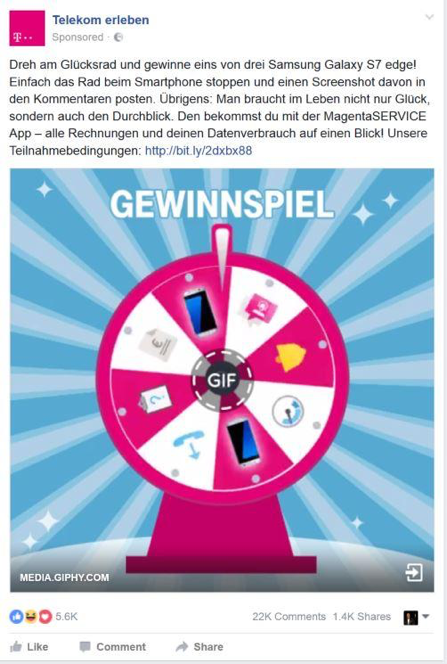
It was quite similar with Sportscheck’s award winning GIF. There a shoe fell from top to bottom again and again. The GIF should be stopped when the shoe is exactly in the outline. And people did it gladly, many times.
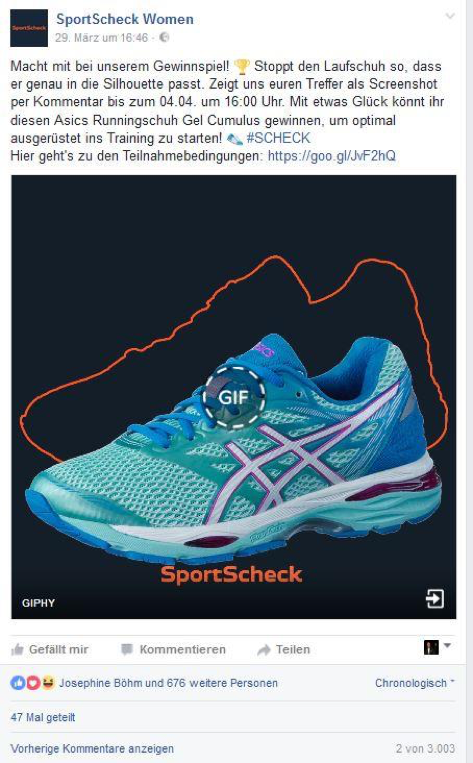
Even without an option to win some kind of award, such a post can achieve high engagement rates and a positive brand perception. Arizona Icetea has released a similar post in which three cans fly into the picture and just need to be stopped at the right moment.
The benefits of such posting strategy are obvious: a GIF is relatively easy and inexpensive to create. The fans engage themselves voluntarily and playfully with the brand (playful approach), spend a relatively large amount of time on the post and interact with it strongly (EDGE-rank). GIFs can be a useful contribution to a good content strategy.
How to create an animated GIF?
To create animated GIFs, you can use programs like Photoshop or GIMP. Instructions are available on-line (YouTube, …). But platforms like Giphy also have their own GIF Maker, which directly produces an animated GIF from a series of images or a video: https://giphy.com/create/gifmaker.
How to use animated GIFs in social networks?
On Twitter, you can upload the animated GIF directly from your own computer. Facebook uses GIF databases, especially tenor.co and giphy.com. If you upload GIFs there, you can copy the link directly into a post, Facebook then creates the GIF.
As I said, currently there are some difficulties with GIFs on Facebook (some are then displayed only as a preview image with a link to Giphy). Here to hoping, that Facebook will soon eliminate this problem.
1.2 Provide GIF for comments
The second GIF strategy is more of a long-term, but if it works, it’s extremely valuable. This is not just about posting something, it’s about getting users to post.
The strategy is to upload a whole series of GIFs that are animated on different occasions, which are then available from Facebook in the selection of GIFs. Users looking for GIFs can then select the appropriate GIF and hopefully (at least in part) decide on a company GIF. Of course, for a marketing effect to occur, brand components must be included, for example, through cleverly placed images, the use of logos, colors or similar elements.
A good example of this is SIXT. The car rental company maintains its own GIF archive at https://giphy.com/sixt. Of course, these GIFs are intended primarily for your own social media team, who can then post the GIFs in response to user comments.
Increasingly, if they get popular, also “normal” users will use these little pictures for their comments (on the SIXT site, but also in their own discussions on Facebook). SIXT has uploaded a lot of GIFs for various situations, emotions or potential answers.
It is important that the GIFs are well indexed on the corresponding GIF platform. It should use the terms that users are looking for in the GIF selection on Facebook. For the term “I-dont-know” (the SIXT in Giphy as a catch phrase) has deposited, the SIXT-GIF already comes in second place.
Green Cola uses a similar strategy, with the tenor.co platform for their GIFs (https://tenor.com/search/greencola-gifs). Although only a few GIFs were uploaded, they are marked by a recognizable branding (person, color) and are sometimes even used by companies in the comments, as here in the example of EDEKA.
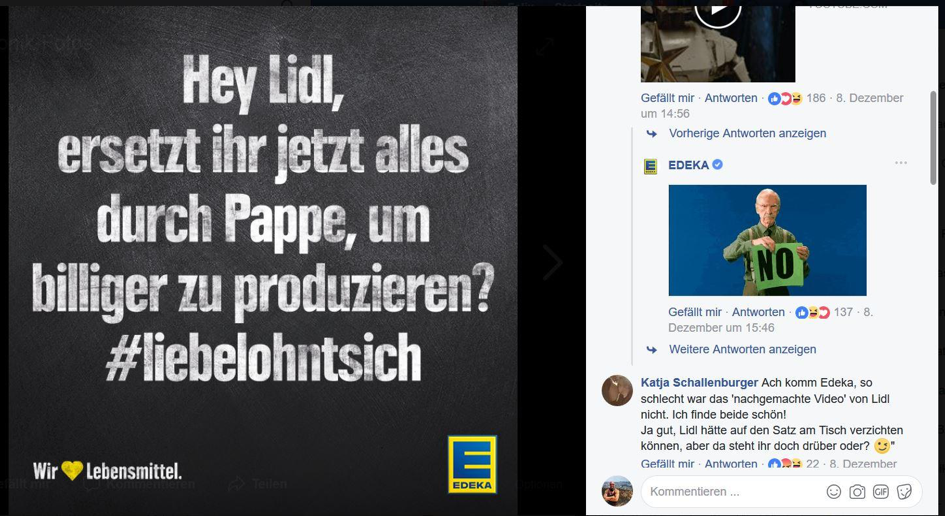
- Ask me anything (AMA)
Ask me anything is a relatively well-known social media tactic in the American cultural area, but very unknown in this country. As the name suggests, somebody answers the questions of the target audience, usually during a fixed period of time (for example, during a 30-minute livestream). The principle can be used with quite different formats:
- Donald Trump and previously Barack Obama were running AMAs on Reddit (with Trump moderating critical questions).
- Bill Gates has also already answered the questions of the Reddit community.
- The journal Internetworld.de regularly carries out AMAs by means of a commentary software, the questions are answered by experts on the respective topic.
- The mobile phone manufacturer OnePlus has carried out an AMA in the in-house forum and answered questions about the new mobile phone model.
- Fitness legend Joe DeFranco uses the AMA strategy on Instagram and answers the questions in his podcast.
- Before the 2017 general election, Yodel users were able to ask questions to top German politicians in a live question and answer session. Yodel displayed each questions and other users could up or down-vote the questions. The best questions were then put to the politicians.
Above all, Reddit has established itself as an AMA platform in the USA. In addition to the before-mentioned Trump and Obama, many celebrities have already answered the fans’ questions there, including: Snoop Dogg, Elon Musk, Madonna, Channing Tatum or Edward Snowden.
Ask me anythings produce a high degree of perceived transparency, service orientation, customer proximity and helpfulness, but also require a little courage to face the questions so openly. This is especially important for live formats, where critical questions can not be easily bypassed. Anyone who has reservations here should rather choose a procedure where questions are submitted in advance and these are then answered in writing or in the video (possibly even without commenting option). Of course, some of the benefits mentioned will be eliminated.
In principle, AMAs can be carried out mainly in the following formats:
- Livestream (Facebook, Periscope, YouTube, etc.)
- Collect questions and answer collected questions (for example in the video,
- Podcast, or by text)
- webinar
- Reddit, Yodel or other app
- podcast
- Forum, chat
- The AMA method is particularly well-suited to companies that have a well-positioned, publicly known person as a figurehead. But of course the questions can also be answered by an expert or support team, or even on behalf of the brand, especially if it’s not about a video or live stream, but the questions are answered in writing.
Ideally, such AMAs take place on a regular basis, perhaps on a specific topic or simply mixed (depending on the number of questions). So that the AMA is also found by non-followers, it should be provided with the hashtags #AMA and #AskMeAnything.
Similar formats can also be seen in many companies, without them explicitly mentioning this as AMA. Lawyer Christian Solmecke, for example, answers user questions on YouTube every week, but simply calls it “user questions”, even though it’s essentially an AMA. Of course, the name does not detract his tactic from its popularity and effectiveness.
- Takeover
A particularly nice tactic for companies that either can not produce enough interesting content themselves or simply want to “outsource” part of their work to third parties is social media takeover. In the US, this principle has long been known, and in this country, it is used heavily in some industries (such as fashion, fitness). In other industries, it is completely unknown.
In short, in a takeover, a third party takes over a company’s social media channel for a limited period, usually Instagram or Snapchat, but Twitter and Facebook are also possible. Sometimes takeovers happen only in the stories, and the regular Instagram feed stays untouched.
The best known form of Takeover is certainly the Influencer Takeover. As the name implies, influencers and well-known personalities take over the channel. It is important that the influencer in the target industry is known and popular and covers the target groups as far as possible.
The influencer now gets access to the company’s social media channel for a certain period of time and can independently create contributions. It would also be conceivable that he sends the pictures, videos and texts to the company and the posts are then published by the local social media team. But that’s where spontaneity and authenticity suffer. It is better to agree with the influencer-based and contract-based influencer. Corresponding rules regarding the desired and in no case post-content are of course important, as well as the selection of influencers.
The period is often chosen, for example, for the duration of an event, e.g. during a trade fair day, a concert or a sporting event, but sometimes also during a weekend or even during multi-day periods. Usually then a minimum number of postings is agreed, so that the takeover is worthwhile.
In addition to the classic Influencer Takeover, other forms are possible. The Tourism Authority of the country of Sweden has been e.g. for many years every week twittering another Sweden with the official Twitter channel twitter.com/sweden. The citizens can apply and are then selected. The goal here is to provide as authentic insight into the life of the Swedes as possible.
Even fictitious takeovers are possible. So Honda had a few years ago created their advertising character Skeletor (the opponent of He-Man), who took over their Twitter channel (http://felixbeilharz.de/skeletor-uebernimmt-honda-twitteraccount-geht-social-media/).
- Group strategies
Another strategy that is used by far too few companies: the use of groups. In principle, this is comparable to the forums that existed before the actual social media term, only that the structure of such a forum was always provided with relatively high hurdles, in terms of effort and costs. Creating a group on Facebook, XING or LinkedIn is quick.
Using groups in marketing has several advantages. In addition to better customer loyalty and the development of a community, the coverage benefits play a major role, especially on Facebook. Group contributions are considered much more in the newsfeed than contributions from fanpages. At least with the group members you have the chance to show up in the newsfeed again.
For a few months, Facebook groups can also be operated directly from fanpages, so there is no need to engage any more people with their profile (at least when running their own groups). Basically, group strategies can be divided into two categories: becoming active in foreign groups or operating your own groups.
4.1 Use of foreign groups
This strategy is particularly suitable for lone fighters and all advisory professions where a person is visibly in the foreground. In short, it is about finding suitable groups in which the target group exchanges, and there to be active with words and deeds.
It is generally important to know the groups that are relevant to the target group, as they ask questions and discuss issues that may be important to one’s own marketing or business as a whole. The search functions of social networks usually help you quickly to find suitable groups. The suggested groups (Facebook, for example, at https://www.facebook.com/groups/) often help. Also a Google search with the site: facebook.com/groups/ (+ keyword) command, for XING analog site: www.xing.com/communities/groups/ (+ keyword) can bring interesting groups to light.
Important: Do not spam groups indiscriminately with your links or even your ads. Instead, build a reputation in the group by posting helpful answers or interesting content. Then plate advertising is usually not necessary because people come by themself to seek your advice or you are recommended by others.
A good example of this strategy is lawyer Rolf Claessen, who is on Facebook a member in pretty much every Amazon group. As a patent attorney specializing in patent and trademark law, he mainly looks after Amazon dealers in trademark and other e-commerce issues. He reads carefully in all these groups. When asked the appropriate question, he posts a link to one of his YouTube videos in response.
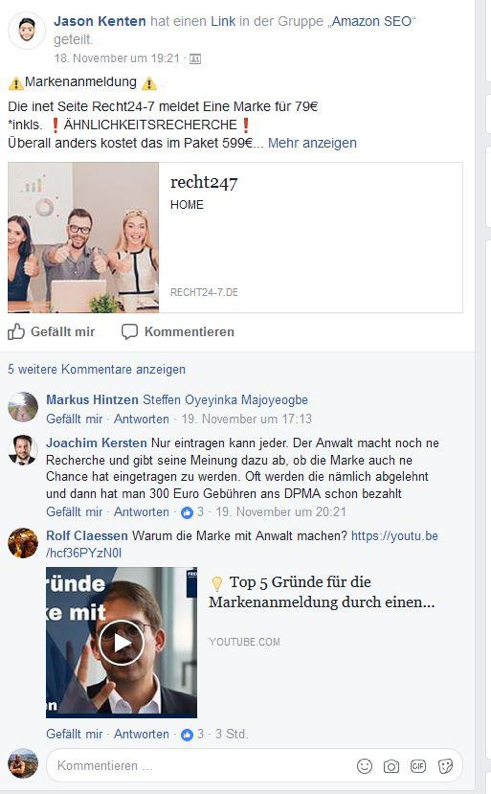
This is then not perceived as advertising, because he does not sell directly, but offers assistance to the specific question. More and more he is also recommended to members who are looking for legal support.
This strategy is of course time-consuming and takes a while to come to fruition, but then becomes a valuable customer acquisition asset and contributes greatly to expert positioning.
4.2 Use of own groups
Another good tactic is to raise your own group. Building up your own community can be confidently called the “premier class” of social media marketing. In an existing social network, the effort is significantly lower, since at least all technical, hosting, software updates and many other measures are eliminated. Nevertheless, of course, a group must first be brought to life and then kept alive.
However, the company is rewarded with a strong community that can be “feed” with content and occasional advertising. And unlike the first strategy, here you are the
only one who is allowed to advertise. You dictate the rules instead of submitting to the rules of foreign communities.
Some examples of the group strategy:
The German Institute for Marketing operates on XING the group “Marketing Knowledge”, in which only people are invited, who work in the marketing of companies (and of course represent the target group of the institute): https://www.xing.com/communities/ groups / marketing know-007b-1068181
The training provider LVQ operates a group for former graduates on XING, which leads to strong customer loyalty and numerous other bookings: https://www.xing.com/communities/groups/lvq-alumni-netzwerk-007b-1024600/about?sc_o = da980_e
The web design agency Endcore operates one of the largest groups on SEO & WordPress. The group is now maintained by numerous moderators and is constantly growing: https://www.facebook.com/groups/wordpressundseo/
AXA representative Robert Kosik builds his own groups for entrepreneurs (and thus potential customers) from the region, including: https://www.facebook.com/groups/business.limburg.weilburg/
The Content Marketing Institute runs a large group on LinkedIn: https://www.linkedin.com/groups/4342574/profile
Haufe Verlag operates the “Marketing & Sales” group on LinkedIn: https://www.linkedin.com/groups/2835601/profile
Adidas recruits prospective employees through a LinkedIn group: https://www.linkedin.com/groups/2561891/profile
The DuMont publishing house in Cologne operates the group “You come from Cologne, if you …” (similar groups exist for almost every city, but mostly operated by private individuals): https://www.facebook.com/groups/259637790816108/
Important in this strategy is that the group promises and maintains sufficient added value so that it is truly a one-stop-shop for the target group. Basically, you can proceed in two different ways:
1. The group is raised on behalf of the company. Especially interesting for strong, popular brands and if the target group is existing, customers should be bound to the company.
2. The group is not raised in the company name, but on a topic. This is especially useful if a suspected advertising is to be avoided and the company first wants to build a reputation in the target group. This approach may be similar to the next strategy, the Passion Pages.
5. Passion Pages
The strategy of the Passion Pages is always used when the company is unknown or does not want to be known (because the brands play the main role, not the company as sender) and even if/when the company, the brands or the products are to “boring” for social media. What should you write about screws, cables or cough syrup, that isn’t written already? And who cares what Klosterfrau says on Facebook?
Passion Pages are pages in which the focus is not on the company and its products, but (only for now) on an issue. These pages are also not called “Friedrich Müller GmbH & Co. KG”, but have an attractive name that makes you want to become a fan. From the outside it is often difficult to see who is behind the page. Of course, if you look into the imprint of the owner, you can see it clearly, but who does that anyway?! …
Such Passion Pages have a few distinct advantages:
Since they do not look like advertising, they enjoy a higher acceptance among the fans, the hurdle to like, is much lower than on a corporate page.
A corporate site gets especially fans who already find the company great. But what if I want to address people who do not even know me? Nobody becomes a fan of a company to which he has no relation.
The contributions are usually much more willing shared or liked, since they come less promotional.
For some companies, Passion Pages are even the only way to market themselves visible online because they are just too boring or lack the creativity to tell an interesting story.
However, the great advantage is also the big disadvantage: The brand is not in the foreground. As a result, a branding effect takes place much later and often can not be measured as clearly.
But that can be compensated very well by an appropriate two-tier advertising strategy. Because here is another important advantage of this method: who liked the fan page “I’m a passionate teacher” is most likely also a teacher. That means with Passion Pages it is very easy to select target groups in advance. And these can then be targeted extremely accurately with ads. Professional groups on the other hand, are usually much more difficult to target on Facebook.
By no means all users indicate their (true) profession. And you can not get beyond interest targeting here anyway. However, anyone who has gathered 20,000 fans for the fan page “Tips & Tricks for firefighters” has generated a perfect audience, which he can address very competitively with ads.
Two well-known examples from practice show how the principle can be implemented.
The Klosterfrau Healthcare Group runs the fan page “The Men’s Flu” (the overall strategy also includes a website, appearances on Twitter, Instagram and YouTube as well as offline advertising media in pharmacies).
The products themselves are rather boring – nasal spray, throat tablets, cough syrup. Nothing that people usually like and share with great enthusiasm. The funny videos and sayings are sometimes shared thousands of times. The company has (with their agency) just occupied an issue that was previously a social gimmick in the social web and masterfully seized. Not for nothing one of the most successful pharmaceutical campaigns of recent years.
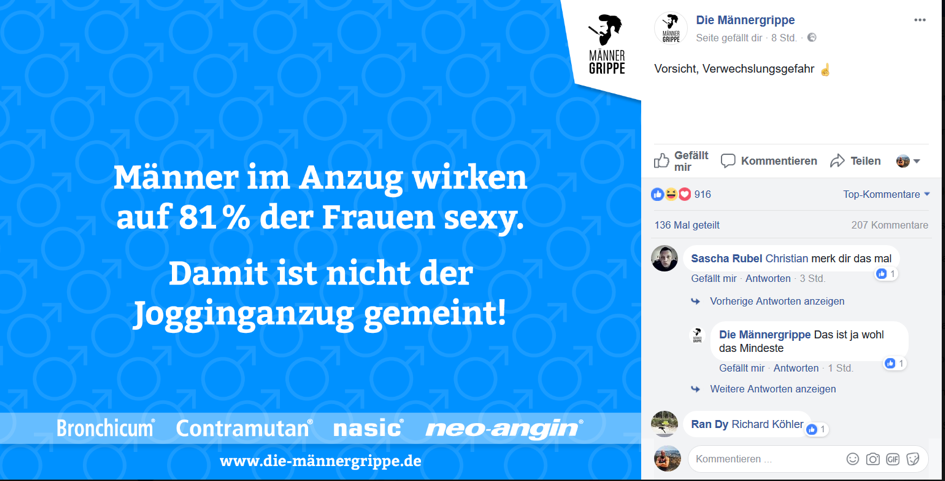
A second example of the Passion Pages strategy comes from the food sector. The company Savencia knows hardly anyone in Germany, a company fanpage would not make much sense. Brands such as Bressot or Géramont, on the other hand, are well known and loved. However, the company sells about 20 cheese brands – to look after all their own social media appearances is time-consuming and difficult.
So you chose the way of the Passion Pages. With “Ich liebe Käse” (“I love cheese”), a brand was created that is now being displayed on Facebook, Instagram, Pinterest, Twitter and YouTube as well as on the website www.ich-liebe-kaese.de and even has its own app. The content strategy consists predominantly of recipes in which the brands are used. As a result, there is also a sales approach (which is seen rather indirectly in men’s flu). It’ss complemented by interesting facts about cheese, cheese know-how and playful entertainment content.
The nice thing is that a large part of the approximately 500,000 Facebook fans probably don’t even know that they have actually liked a company page, but simply feel at home in the community of cheese lovers. The brand message is channeled through the “back door”.
The Passion Page approach is particularly suitable for smaller companies that nobody (yet) knows and who are building their brand awareness. Here are some examples of this approach:
- The page “I am a doctor” is operated by a digital agency that specializes in doctors:
- https://www.facebook.com/IchBinArzt/
- The fire department of Lower Saxony presents itself neutrally as “yes to the fire brigade”: https://www.facebook.com/JazurFeuerwehr/
- Dogspot, a dog community, operates probably the largest dog site in Germany: https://www.facebook.com/hundefreunde/
- Frontal videos / explanatory videos
For this tactic I do not know a real name (and none of the interviewed colleagues could tell me a specific name for it yet). So I just call them “Frontal videos”. The principle is simple: someone stands in front of the camera and explains something. The already mentioned AMAs can be, for example, an expression of the frontal videos.
Frontal videos are characterized by the fact that the effort for the creation is very small. In contrast to almost all other video formats is little equipment, little editing and little preparation and post-processing necessary. At the same time, however, the perceived benefits are very high. Who wants to see product presentations or corporate videos on YouTube? Well-worded explanations of important topics, principles or processes, on the other hand, are often viewed and often shared.
Of course, this technique requires someone to stand in front of the camera. This should either be an employee of the company or a trusted person known in the industry. Employees (or even executives) are usually preferable, as they pay more for the company’s brand account.
The prime example for frontal videos is lawyer Christian Solmecke, who is well known in the online industry. With his YouTube channel (https://www.youtube.com/user/KanzleiWBS), which consists exclusively of explanatory videos, he has now reached more than 180,000 subscribers and over 30 million video views, building Europe’s longest-reach Jura channel.
So that the frontal video concept is not boring, he incorporates various other principles. For example, once a week he answers user questions, which he collects under the hashtag #fragWBS. Other regular series also provide variety, e.g. “The 5 …”, where e.g. the most curious court decisions or the most absurd laws are presented. A very clever tactic was also the series “law for YouTuber”, with which he made a name for himself as an influencer. Especially interesting is #ChallengeWBS, where he answers as many user questions as possible blindly (ie without preparation) within three minutes.
Another good example of frontal videos is the Cologne pharmacist Steffen Kuhnert. In just one year, he has collected over 13,000 subscribers and over 1.3 million video views on YouTube. He deals with all health issues from the point of view of a pharmacist and health expert.
The most popular videos on his channel are about smoking (for example, “Shisha – How Harmful is Hookah Smoking?” Or “E-Cigarettes – How Harmful Are They Really?”). He too “simply” sits in front of the camera and discusses the topic. Similar
to Solmecke, he does not read, but tells in a relaxed tone and even adds a personal note, that makes listening easy and interesting.
The two biggest dangers of frontal videos are that they get too boring and that you “slip off” into advertising content again. You should avoid both, so that the format works.
A minimum of quality should of course also be given in frontal videos. This includes a good camera quality (a normal DSLR camera is sufficient, some videos are synonymous with good phones rotated), good illumination (3-5 studio lamps are useful) and a good sound (external micro, recording device) are the basics. A proper equipment is already available for under € 1,000 and can of course be increased at any time.
Of course, I also use the format myself. If you want to see my frontal videos, you can do that on my YouTube channel https://www.youtube.com/user/felixbeilharzde/.
- Cooperations
Social media co-operations are again such a technique that social media professionals have been using intensively for a long time, but most companies (especially medium-sized companies) have never heard of it.
The principle is explained quickly: Find someone who already has a reach in your target group and offer a cooperation. For this to work, you also have to bring in something. Either own range, money or other benefits. Above all, if there is a strong range gap, the potential cooperation partner will ask himself what he has of it. The success of your efforts depends on what you can offer him then.
To clarify the principle, I would like to revert to Christian Solmecke. He has already used various collaborations on his YouTube channel that are well suited as an example:
The aforementioned lawyer Rolf Claessen was a guest at Christian. Conversely, the two have also made a video for Rolf’s channel (which could even double its subscription number.) The video with Christian is still the most visited on Rolf’s channel.
There was also a cooperation with the successful channel “5 Ideas”, which extract the best 5 ideas from business books and make Scribble videos out of them. Dave of 5 Ideas was a guest at Christian, where the question was clarified whether content from books online may even discuss. Christian was then hosted by 5 ideas for a video on “Making money on the Internet legally”.
Even with a defense lawyer, there are some videos.
I was also allowed to cooperate with Christian several times. In doing so, I called on my Facebook fans to send me questions to the lawyer, which I then asked him in several videos. Usually, the view numbers of these videos exceed those of my own many times over.
Paid cooperation is also possible. There are a number of channels and platforms where paid posts can be booked. Depending on the definition, this is already native advertising, which does not detract from its effectiveness.
A good example of such a “buy-able” cooperation platform is visual statements. The Facebook page posts mainly slogans and pro videos. But posts can also be purchased. In doing so, a fixed range is negotiated, which either generates organically or, if that does not succeed, is bought by visual statements through Facebook Ads. So the partner already has a guarantee for the range before the start, which precludes one of the biggest weaknesses of the content cooperation, namely the uncertainty about success or failure.
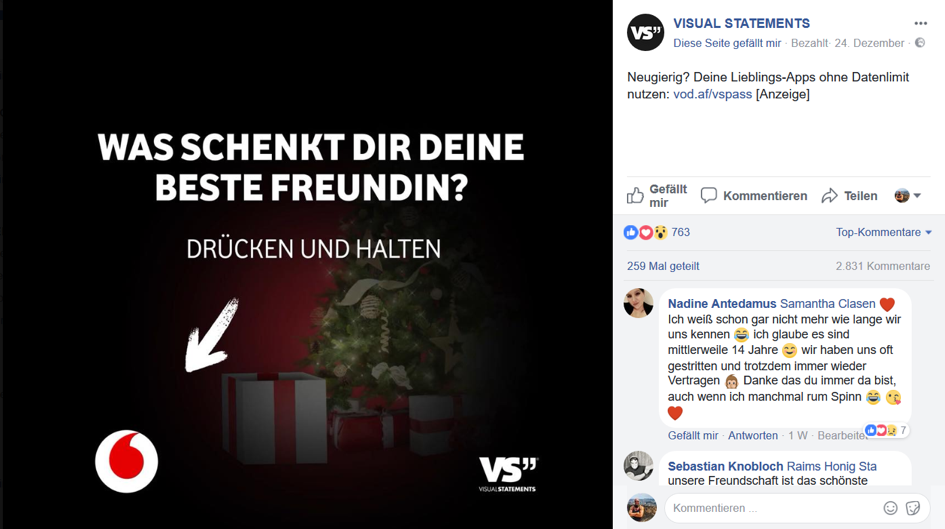
A recent example of paid collaborations comes from Universal Pictures and was used to launch the film The Purge 3, which was released in the fall of 2016. The post was booked on the popular Facebook page Made My Day and played with the fear of Trump’s possible presidency. A pretty clever (and very successful) move.
- Two-tier content
The strategy of the two-stage content is especially used (but not only) in B2B marketing. Often (manufacturers) companies are unsure what to post because they see the problem of not having the end customer contact and, therefore, do not display content directly to the end customer (which they certainly should be doing …).
This can be handled with two-tiered content. The company produces content and shares it on the social media (or makes it available elsewhere), but not with the goalof reaching end customers, but with the goal that the customer companies then share the posts themselves (or post new) on the feeds of the companies, which ultimately have the end customer contact.
Like all of the strategies, tactics, and techniques listed here, there are many benefits here as well. The biggest one is probably that it is often received very positively by customers, because they save themselves the effort to create their own content. It is therefore perceived as a service (and even if you think it through to the end, it can also be included as part of the service strategy). At the same time, the manufacturer has more control over what the customer companies communicate to end customers.
The fitness courses provider LES MILLS (partially) pursues this strategy. The content will be created to fit the fitness studios that ultimately offer the courses and their members. Accordingly, the posts are often shared by the gym. LES MILLS could do a lot more though, there is definitely still room for improvement.
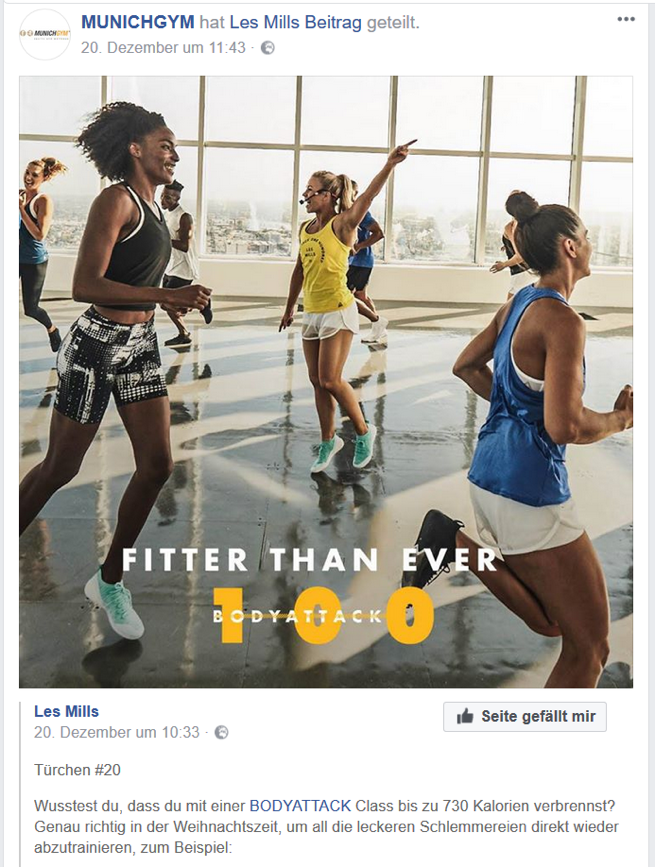
For this strategy to work, the key question should not be “What are our customers interested in?” (As with “normal” social media strategies), but “What are our customers’ customers interested in?” Or “What content makes our customers look good with their customers? ” If combined with the brand message, the strategy can be very successful.
- Egobait
The last social media tactic may also be one of the most important ones. In the online industry and especially in SEO, we have been used to this for a long time, outside of which examples are rarely found. We are talking about the “Egobait”.
The Egobait does not place the company, its products or services, not even its topics in the foreground of the content. Instead, it’s all about a third person, usually an influencer or a well-known personality in the industry. The egobait “tickles” the ego of this person so that s/he feels almost obligated to share the contribution. So it’s a clever form of influencer relations, but unlike traditional influencer marketing, it usually manages without big budgets.
This strategy is often used in blogs and can occur in many different ways. Common forms of Egobait are:
- interviews
- Ideas of persons
- Quotes Collections
- Tip collections or trend assessments
- leaderboards
- Awards / Awards.
If things go well, an egobaite can provide tremendous reach in no time. At the start of the platform, the SEO portal was geared towards an egobait, in which a list of the top 100 SEO influencers was defined and put online. Of course, this is something that gets around quickly and the platform was well known in the industry (https://seo-portal.de/die-top-100-influencer-2015/).
Of course, most of the people in the list shared the link, and many others found it so helpful that they were diligently talked about. Even some of the non-listed persons contributed to their dissemination ;-).
SEO-Portal has repeated this tactic several times and caused a stir and traffic every time.
A very similar approach choose the “Success Magazine”, with a journal for, well, success. Both in the magazine, as well as online, a list of the “Top 100 Success Trainers” was published. How this list was put together and how the rankings came about is completely open (the list goes from the convicted offender to the fitness creator to the long-dead motivational guru or Facebook fan buyer), but hey, the principle was successful, was hotly debated over the list. As a result, the magazine has dramatically increased its name recognition, with minimal costs.
Collecting citations, tips or other content from influencers has long been part of everyday life in the SEO industry. However, this tactic is completely unknown in most industries.
Ryte.com itself has already worked several times with egobait approaches. So this contest is also a kind of egobait. The prize money is certainly nice for most of the participants, but for the most part, most of them are more likely to win and thus gain image, which Ryte can also claim for himself.
By the way, by the way, wearing a Ryte shirt on my Egobait YouTube video is actually a coincidence, but it shows well the effectiveness of this principle.
Egobaits are particularly well suited for people who are exposed, (in addition to online marketing) for example in industries such as fitness, finance, fashion and many other topics. And even in sectors where there are no exposed heads at first glance, egobaits are possible: actions with employees or customer of the month are ultimately nothing more than the forefathers of the Egobait.
Conclusion
That was 9 out of innumerable approaches that can work well in social media marketing. For each example: do not hang on the example only. Always ask what lies hidden in it for you. What can you learn from it? How could you test this principle adapted to your industry? What ideas can you “steal” from the other industry? And then adapt it to your industry and target group, stamp your stamp on and off you go, with the great post. I wish you success!